A Paipo
Interview with Lewis Cawsey
March 9, 2014 - Cronulla, Australia
Phone interview by Bob Green
Growing up near the ocean and an interest in sailing
craft, led soon
enough to Lewis Cawsey going surfing. His early days were spent riding a
coolite board [see Note 1]. Like many young surfers of the time he then made and
rode a board of his own construction, likely influenced by a magazine
photo or movie image he'd seen. The powerful point waves at Cronulla
provided a perfect place to ride a simple planing machine made of wood.
Before leg-ropes and shortboards, Lewis and his friend Greg, amongst
others would ride paipo boards at Cronulla. His board also doubled as a
skimboard, versatile in the waves, on the sand and shorebreak.
|
1. I gather
you rode a paipo around Cronulla at some stage?
Growing up in
Cronulla, you are brought up
swimming, surfing, fishing and taking out a boat whenever you could. I
always used to swim with the guys from school at South Cronulla,
however, I broke away from the group one day and started to swim at
Cronulla Point. How it happened was a guy from the surf club told me
how good it was, so we swam out to the point to catch waves where there
were other surf club members body surfing all the time. From then on I
could not stop going out there for good waves and the power, it was so
exciting. Next came the hand plane, then belly board / paipo, then surf
boards.
When was this do you reckon?
I
was 10, and the year was 1960, when I started surfing at Cronulla Point.
The surf club guys out there taught me how to bodysurf the point
properly. The technique for the point is quite different to other
bodysurfing techniques, as you needed to harness the power on the steeper,
hollow and fast waves, it was really different from the beach waves. It
was a place I liked. To ride properly you would use your right hand down your side like a fin
and the left hand to support yourself on the face of the wave. Cronulla
Point is very powerful.
2. How did you get into
riding a paipo board?
At home we used to
make our own boats and we
had marine ply. I got the idea of what was going on in the surfing
scene and made my own paipo board. I had a mate up the street, Greg
Vaughan, who ended up buying his own bellyboard (two fins) from school
friends. Swim fins came from the Bob Frazer Sports Store in Cronulla, near
the theater. Greg's board had a laminated wood resin finish and two
fins—nice board. Mine was just marine ply and varnished. My ply paipo
board was also used as a skim board when the surf wasn't working.
So for how long did you ride the paipo board?
From 1963 to 1965. After that era I rode surf boards. Alan Breakspear
introduced me to board riding with us kids sharing his family's hollow ply
surf board at North Cronulla Beach and around Gunnamatta Bay. My board
riding started at North Cronulla with Alan. I always liked the paipo
more than the board, however, the board won. Got my fist mal in 1965, and
still use it occasionally. I continued to surf the Point and have had
many boards since. Have been surfing with Alan Macoustra at Cronulla
Point since 1966.
They're very different experiences.
Yes they are. Riding a paipo you look up at the shape of the wave,
a completely different perspective to being on a board looking down on
a wave unless of course you're in it, then it's the same view. Paipos
are fast.
Lewis Cawsey bodysurfing with a hand plane and Greg Vaughan bellyboarding, at Cronulla Point.
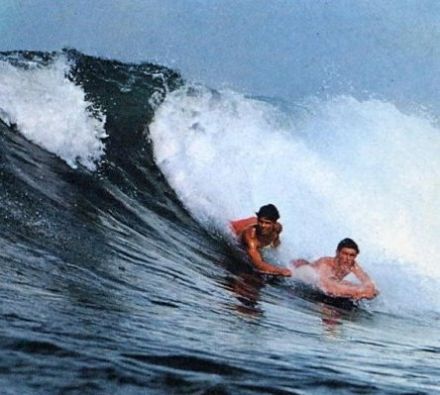
Source: Jack Evans [photographer]. (1965, Summer). Belly
Boards. Surfabout:
Australasian Surfer, 3(1), 1.
3. I've spoken to a few people
from Cronulla. It seemed a hotbed of creativity in the 1960s.
Certainly was. I had two paipo boards. One was made out of an old
Barton board. Barton boards were coolite things five feet long. What I did was
cut two feet off it, get a sander to it and put two concaves on the
base and stuck five fins, large to small radiating out from the center,
in the bottom rear of the board. It worked like a dream but cracked
under pressure. So the next one had concaves and no fins—it worked
well—still didn't handle the pressure well though. Painted the boards
white on the base with a black top and waxed them, just house paint to give
them a smooth finish.
Problem was the coolite was not strong and broke or cracked—so that's
where marine ply came in.
Below, on the Surfabout magazine cover, I'm the bodysurfer and Greg Vaughan is the bellyboarder. I'm
in other photos around the place. Guys would ask me, "Who are you?" and
I never liked to put my name up to people, so I'd just say "I'm just a
local."
Surfabout
cover 1965. Lewis Cawsey is the bodysurfer in the bottom frame with Greg
Vaughan below.
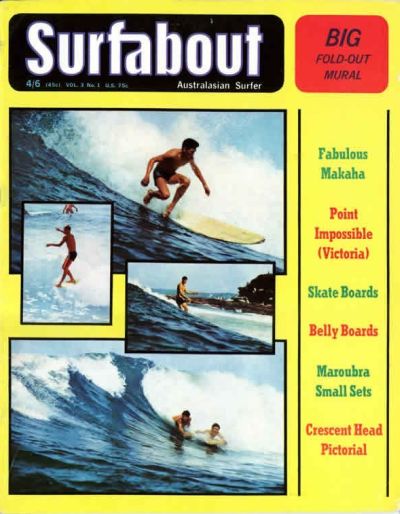
Source: Jack Evans [photographer]. (1965, Summer). Belly
Boards. Surfabout:
Australasian Surfer, 3(1), 1.
Times were different then.
It was against the surf club rules to ride a board with fins in
the surf area, as it is now. One summer's day I was surfing out the
back at North Cronulla on my ply paipo, outside the crowd across the
back of the flagged area—great wave on the day—and when I came to the
beach, out of the surf, I was approached by a surf club patrol guy at
North Cronulla beach. There was a good surf rolling and I had been
riding across outside of all the people swimming in the flags, my board
was a paipo and it had no fins. So it wasn't a problem to be surfing in or
near a flagged area, however, if I had fins on the board, I would have
lost my board and had to pay a fine. Any way this guy picked me,
grabbed the paipo off me. He said, "Where's the fins?" and I said, "It
doesn't have any." He said, "How do you get across the wave?" Then he
handed my board back and said, "Just make sure you don't hit anyone
with it." And then he walked up the beach. I watched him walk away and
he put his hands in the air talking to some guy up the beach saying,
"It's got no fins."
Times then were with good friends and good company. Mid-summer, in the
morning, Greg and I used to leave home at 3:30 a.m., to walk around
Gunnamatta Bay to the beach to go for a surf (no daylight saving). By
the time we walked around to Cronulla main street and the bread bakery
for a free warm half loaf of bread to share, then we were ready for the
day. Morning apple pies were always great from the pie shop. There was
a bit of a lifestyle, local thing going on that was good to grow up
with. There wasn't many out the Point then, just good groups of guys,
body surfers belly board/paipo riders, and board riders. There were
some good surfers in the crowd. There was a guy called Wells, a top
bloke to surf with. I think he would have been the more famous of
anybody who went out there with his distinctive two hand planes and
body surf style—an excellent bodysurfer and nice guy.
Lewis
and Greg. Cronulla Point.
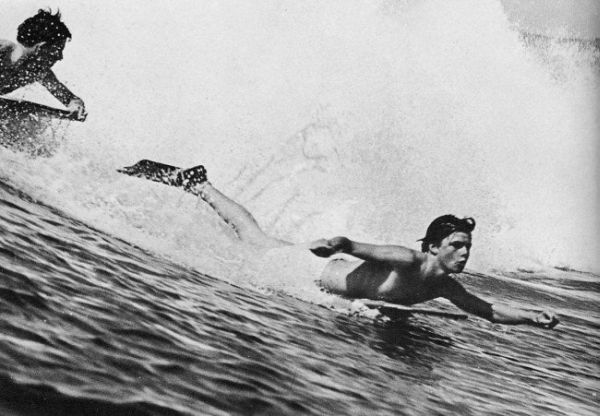
Source: Jack Evans [photographer]. (1965, Summer). Belly
Boards. Surfabout:
Australasian Surfer, 3(1),
44.
4. There must have been a lot
of places along the coast like that but Cronulla probably had slightly
better waves?
The interesting part
about the Point is that it can be 100 percent dynamic and very Hawaiian on its
day.
The Point is a good wave for that type of board.
The Point is a wave that has a stand up wall, that does all the right
things when it works. However, there is a hollow section and a stand up
section (that is hollow when big), and it allows a cut right back to get
into it again and go for another section. Some days it can be the
biggest drop. Just a good wave. It does slam you if you get it wrong.
The take off spot out the back is fully lined-up so everybody knows
where the take-off area is. But it's very narrow to get into the right
spot. Just this little draw that you can slide into. A good wave.
5. Did you know Bozo
Griffiths? That same Surfabout article described him riding a
bellyboard. Turns out it was a kneeboard.
No, I don't, I'm good with faces. There were a couple of guys out there
and I remember a kneeboarder who stood out. What he used to do was get
inside the tube and roll over inside it, making the wave, sometime
kneeling. The wave was fun, we never thought of it as dangerous. That's
what happens, you get used to it. You get done or go down to the bottom
and you hang onto the bottom. What I liked after I got rid of the
coolite board was the marine ply paipo. It meant I could do all those
things I could do when bodysurfing. When the big sets come through and
you get caught out you just go down to the bottom and hang onto a piece
of cunje, stay calm, stay down, the board doesn't float up to the
surface in a hurry, and with decent fins on you just power off again.
You can leave the bottom and you climb up underwater.
Using this
relaxed style you can be underwater for quite a long period of time. I
only found it out years later that Hawaiians do the rock running
underwater as training for surviving big surf. You can go down and hang
onto the bottom and relax, and you get used to the whole idea of it.
That's what I used to do. You get caught out the Point in some of those
big days and you can get really pummeled, you can get pushed to the
bottom so you hang on and relax, and you wait for the bubbles to start
coming up and you know you're okay and you can see the shadow of the next
wave coming, so you pick your time to come to the surface. I never
realized how much influence that Hawaiians had on survival in big
surfs.
6. Do you think there is
much crossover in technique between bodysurfing and riding a paipo?
When riding right on
a paipo board I'd have
my left hand nearly straight down my body to hold onto the nose of the
board so my body was over the front of the board and my right hand
would have been out in front. That's part of the reason I liked the
photo of Leigh Tingle. His body position on the board is just
absolutely excellent though mine was further forward, it's not my style
but excellent at the same time..For me going left was the opposite
position.
Leigh
Tingle at Haleiwa.
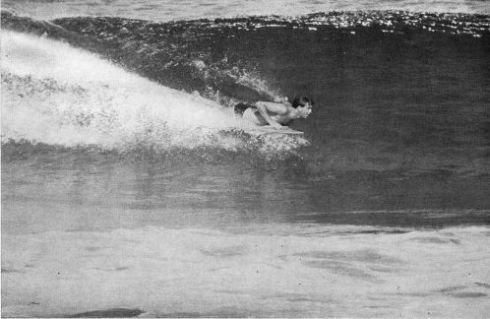
Source: Unknown (1963, Winter).
Spotlight on Hawaii. Surfabout:
Australasian Surfer, 2(6), 13-19. Photo appears on p.17.
Cronulla Point going right body surfing is:
- Right arm down your side hand is used as a
fin.
- Left arm to support you on the wave.
Cronulla Point going right Hand
Plane surfing:
- Right hand out front with the hand plane /
fin.
- Left arm same as above.
How would you turn your board?
Mine had a little bit of flex in it. It's what I liked about the
design. What happens, under the nose I had a slow curve up to the front
edge which is still quite solid and then in the middle of the deck of
the board you dish it out with a sander down to the next layer of ply.
Dishing out the top allowed the board to flex. The profile shape I
like, is similar to the one I have at home now . They're not really
rounded and they're not a point either, but there is a soft curve. It
tapers slightly on the sides and the back corners are a 3" curve and
rounded.
Got caught a couple of times at the Point. I remember I got down the
bottom of a 10-ft. Point wave, on edge, and hit a tiny bit of chop and
skipped out sideways. That's not fun. Nothing worse than slipping out
and going backwards, looking up at the wave that's about to land on you—especially at the Point.
7. Paipo design?
A marine ply paipo
board is excellent, if you
live around the water, you can use them for skim boarding, they're
comfy to sit on out of the water, they're easy to carry around and they
don't take up any space when put away in your room and when used,
they're a dynamic piece of equipment in their own right. There are lots
of paipo designs and to be truthful I was most happy with my homemade
version, compared to others, it didn't cost me a thing. I was right
into design of boats and how water moves around. When it came around to
making a paipo board, I was really comfortable with what I shaped. It
just needed to be a specific width, have a slight taper and curved areas, and
not be too flexible. If they are too flexible they snap or don't go. You
just have to have them so they are really solid but at the same time if
you give them a bit, they flex. It's all about the smooth surface,
slight curve, that little bit of flexibility to make them do what you
want them to do and they are so fast to use. Absolutely excellent.
A paipo board that Lewis Cawsey made for his boys, ca. 1980. This board is not dished out on top and measures 37-1/2
by 21 inches, tapered.
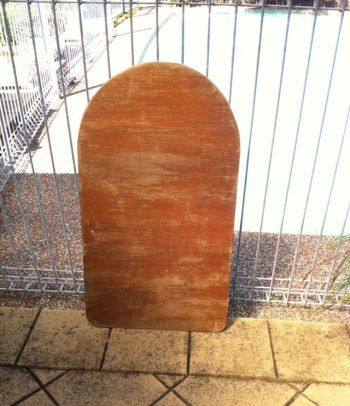
Photo
courtesy of Lewis Cawsey.
8. Lewis and friends sand skiing at Wanda.
We use to skim board at North and South Cronulla beaches,
Gunnamatta Bay and on the local golf links in a big wet, and people took
pictures of us.
We also used to go sand skiing (also homemade) at the Cronulla
sandhills. Look at the size the sand hills were then! On top we were
looking down on the power stanchion. The photograph below is in a
Sutherland Shire magazine, showing five local guys sand skiing down a hill
together. Just mates, left to right, are Unknown, Richard Forrest, Bruce
Forrest, Lewis Cawsey and Unknown.
Sand skiing the North West edge of the Cronulla sandhills near
the big power stanchions, at Wanda.
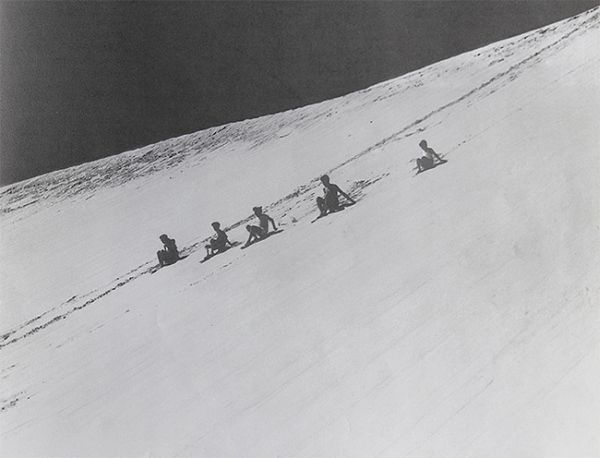
Source: Cronulla
Surf Museum, at http://cronullasurfmuseum.com.au/category/general/.
|
Note 1: In The The Surfin'ary: A
Dictionary of Surfing Terms and Surfspeak, Trevor Cralle describes a Coolite as an Australian brand-name for a Styrofoam trainee surfboard. Cralle cites Mark Warren's Atlas of Australian Surfing as the source for this definition. The Encyclopedia of Surfing
notes that the average coolite was five feet long and 20 inches wide,
with one or two long, narrow finlike runners along the bottom. For more
information and pictures, see Geoff Cater's website, pods for primates : a catalogue of surfboards in australia since 1900.
|
|